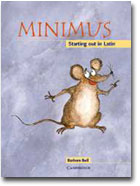
Minimus, Starting Out in Latin
by Barbara Bell
Reviewed by Martha Robinson
Purchase details: Minimus, Starting Out in Latin by Barbara Bell. Published by Cambridge University Press. Student book, paperback, ($22), Teachers Resource Book, spiral bound, ($70), and CD ($21). Please support HomeschoolChristian.com by buying this program from our Amazon affiliate link.
Minimus was written for seven to ten year old British students in both "preparatory and state primary schools." Its twelve lessons combine Roman history in Great Britain with English grammar, culture, and basic Latin vocabulary.
The student book uses cartoon-type drawings to follow a basic story line about a real Roman family who lived near Hadrian's wall around 100 A.D. Minimus, a mouse, introduces the parents, children, slaves, and a cat, whose antics with the mouse provide comic relief. Using details from and photographs of artifacts found around the archeological digs at Vindolanda, aspects of Roman life, such as food, clothing and jewelry, education, bathing, and so forth, are explored.
Each chapter includes the study of Latin vocabulary, grammar, derivatives, culture, and a myth. The lesson begins with a comic strip with Latin dialogue bubbles. Vocabulary appears in the "Words to Help" section along with a few comprehension questions. Next, a grammar lesson explains parts of speech and basic Latin concepts such as gender of nouns. Additional sections on vocabulary or information about Roman life are then shown. The "Latin Roots" page provides about five questions using derivatives of the vocabulary words to help the student discover the meaning of the word in context. For example, after the introduction of the Latin word "circum," the student is asked, "If a yachtsman has circumnavigated the earth, where has he been?" Another cartoon tells more of the story and brings in the new vocabulary, derivatives, and cultural information. The chapter ends with a Greek, Roman, or Celtic myth.
The Teacher's Resource Guide includes thorough instructions for teaching the course. The introduction explains the importance and purpose of each section in the text along with lots of suggestions for teaching that obviously are drawn from the author's experience. Each chapter begins with a brief list of what is covered (subject matter), materials (worksheets), and grammar covered. The comic strips are translated, and every section is explained in detail with extra teaching points. Suggested activities, art, drama, discussion, and many field trips in Britain, are listed at the end of each chapter. Vocabulary is summarized every four chapters, and a glossary is in the back of the manual. Thirty-five reproducible worksheets that offer coloring, maps, Roman writing, and a wide variety of other activities, are also included. A reproducible achievement certificate is the final item in the teacher's guide.
Despite the fact that this program is used in public schools in Britain, Christ is mentioned in it several times. The timeline on page four of the text mentions the meaning of B.C. and A.D. as being "before Christ" and "anno Domini" as well as showing the birth of Christ on the timeline itself. A notation about the origin of the word "petrify" in the teacher.s manual states, "In the New Testament, Jesus said he would make Peter the rock (petrus) of his church." One of the questions on worksheet five is "What well-known Christian prayer begins Pater Noster?" A suggested activity is to "ask pupils to write a prayer which asks for help with the problems of hunger, war, disease, etc. for use in an assembly."
The audio tape [CD in current versions] has actors speaking the parts of each of the characters in the book. The comic strips are read using classical pronunciation.
Recommendation: Minimus is a fascinating introduction to Roman culture, basic Latin, and grammar. The emphasis on the history of Romans in Britain makes the book unique and will strike a chord with many Americans who are of British descent. The suggestions for what could be seen in museums and at the archeological digs had me ready to jump on a plane to England! While this program only brings up the very basics of Latin (first two declensions and present tense only), it excels in building interest in Roman times, people, and culture. The teacher.s manual is easy to work with, and the books are very attractive. While the author says, "It is highly desirable for pupils to read their Latin aloud," the audio tape would not be required. A basic classical pronunciation guide is included, and families who prefer ecclesiastical pronunciation can use a guide from another source to pronounce words properly. The only drawback with this program is that it is a bit more expensive than many of its competitors that actually offer more Latin, but a bit less culture and history. Minimus is an outstanding starting point for elementary aged students.
HomeschoolChristian.com resources related to this review:
Latin Curricula Comparison Chart to help select an introductory or intensive program.
HomeschoolChristian.com's Classic Languages Resource Section
Find more helpful reviews on HomeschoolChristian.com's Review Page Index!
Reviews represent the opinions of the authors rather than the views of HomeschoolChristian.com.



